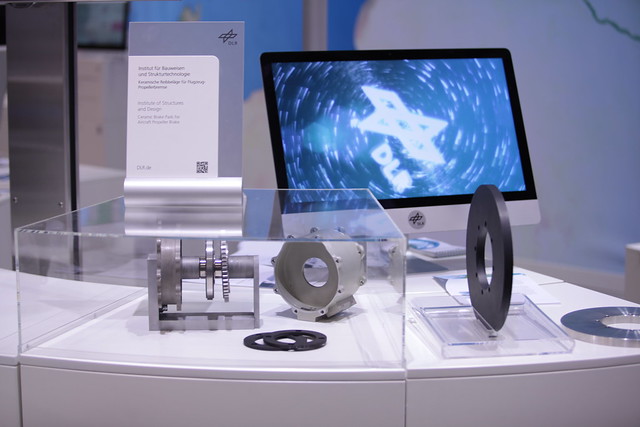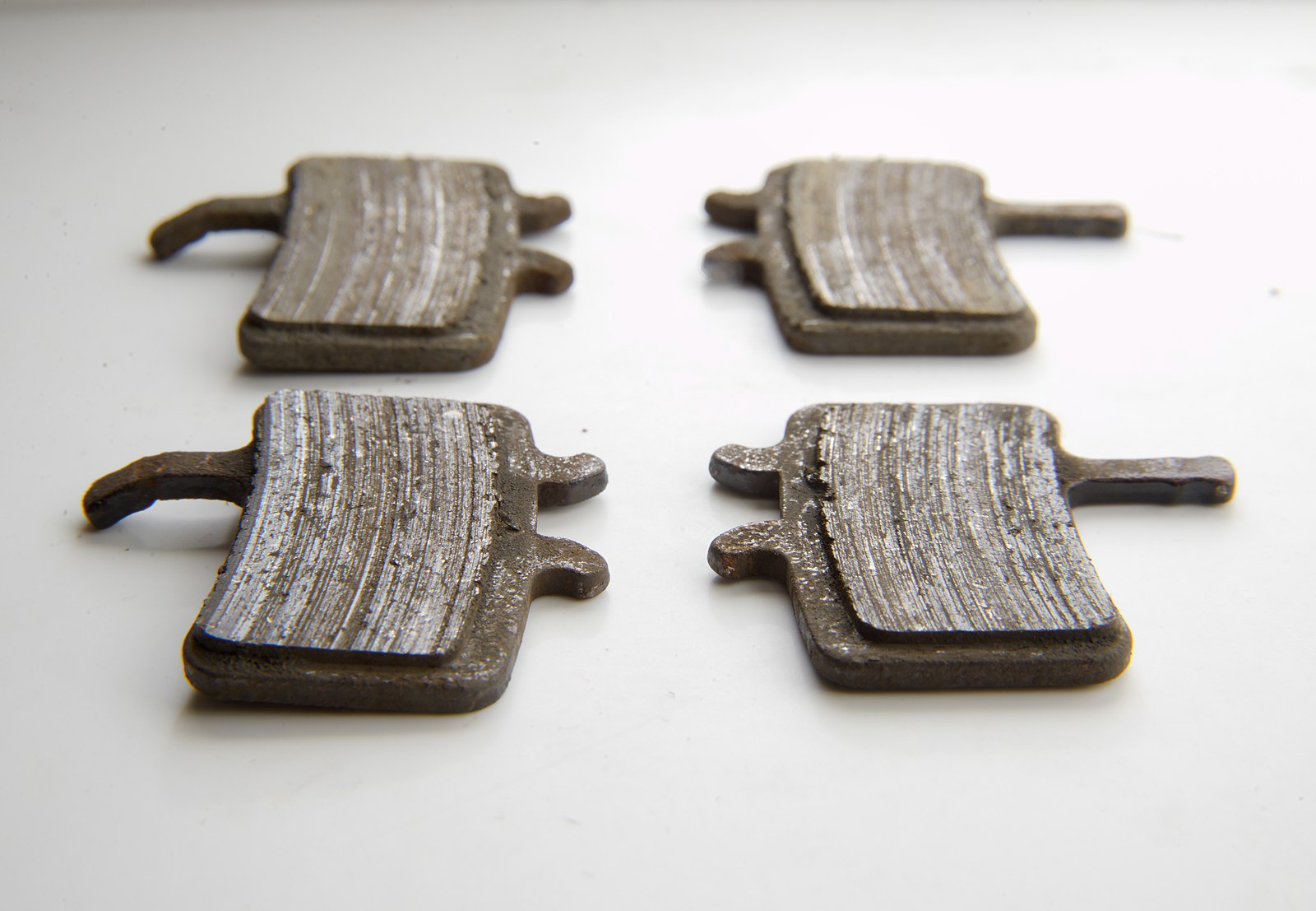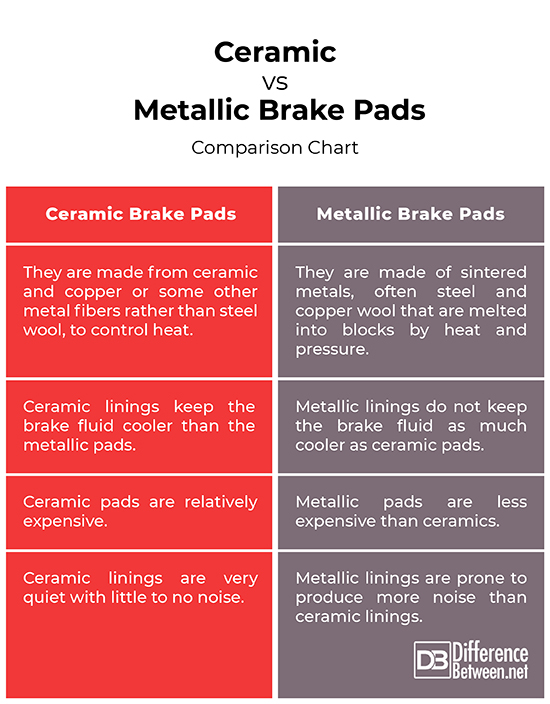Difference Between Ceramic and Metallic Brake Pads
• Categorized under Auto,Objects | Difference Between Ceramic and Metallic Brake Pads
Automobile braking system plays a crucial role in vehicle safety. In the recent years, with the advancement in vehicle technology and the increasing speed of the vehicles, the importance of braking system in automobiles has become more apparent. The main importance of a braking system is to install every vehicle with an efficient braking system to bring the vehicle to rest within a reasonable distance under the most adverse conditions. The brake is simply the brake system of the vehicle, which affects the driving safety of the vehicle. The brake pads are the heart of your vehicle’s brake system.
A brake pad is the part of a brake master assembly that holds the lining friction material that is forced against the rotor to create friction to bring the vehicle to a stop. Asbestos has been most efficient and popular brake lining material for years, until the potential health hazards of asbestos have led to its removal from the braking systems. Other commonly used lining materials in widespread use today are ceramic, semi-metallic, and full-metallic linings. We take a look at the ceramic and metallic brake pads, particularly the difference between the two, to help you better understand which one’s a better choice.

What is Ceramic Brake Pads?
Ceramic is one of the popular options as the brake pad of choice today. Almost half of the vehicles use ceramic linings as original equipment and aftermarket ceramic brake pads are also available out there. These brake pads are made from ceramic and copper or some other metal fiber rather than steel wool, to control heat. The steel in semi-metallic brake pads tends to make noise, wear rotors, which accumulates a lot of dust affecting the performance of the wheels. The ceramic material and copper composite linings make much less noise and do not damage rotors, and create virtually less dust. In addition, they have more stable friction than semi-metallic pads. These materials are used for rotors in high-end vehicles.

What is Metallic Brake Pads?
Metallic linings are made from powdered metal that is formed into blocks by heat and pressure. They are used in vehicles that would operate under heavy-duty conditions and in auto racing. Made of iron, copper, steel and graphite, these materials are mixed together and bonded to form the brake pad. Metallic linings are fused together using a process called sintering, which forms powdered metal without melting it. They provide a good balance between performance and durability and they are very effective for extremely high-heat applications. Semi-metallic linings use a high content of metals, usually exceeding 50% in weight. Steel fibers are used in great abundance along with copper, copper alloys, and tin and zinc in some cases.
Difference Between Ceramic and Metallic Brake Pads
Lining Material
– Metallic linings are made of sintered metals, often steel and copper wool that are melted into blocks using copper, bronze, or steel with other metallic compounds such as iron and graphite. This process is called sintering, which creates powdered metal without melting it. Ceramic brake pads, on the other hand, are made from ceramic and copper or some other metal fibers rather than steel wool, to control heat. Semi-metallic linings use a high content of metals, usually exceeding 50% in weight. Steel fibers are used in great abundance along with copper, copper alloys, and tin and zinc in some cases.
Performance
– Ceramic brake pads have more stable friction characteristics than semi-metallic linings, and they are highly resistant to heat with a very good friction coefficient of .37 –.38 and wears very well. And their friction coefficient does not drop as fast as they get hot. Metallic linings typically have friction coefficients around .37 –.40, depending on the metal used. Iron is in great abundance of that. Semi-metallic linings are basically in the composite category but with a high metallic content. Metallic linings provide excellent resistance to brake fade but require high pedal pressure and they provide improved braking performance under the most severe conditions and temperatures.
Noise and Dust
– Ceramic linings are very quiet that results in a spontaneous response behavior and lower pedal forces. The high thermal stability characterized by a high and widely constant friction coefficient, guarantees a good braking and noise behavior even on harsh road conditions. The metallic linings, on the other hand, are prone to produce more noise as the steel in the pad rubs against the rotor, creating a metallic grinding noise. The ceramic material and copper composite linings make much less noise and do not damage rotors, and create virtually less dust than metallic linings.
Price
– As far as price goes, ceramic brake pads tend to be on a higher side, thus ceramic brake discs are used in many sports cars, high-performance premium sedans and sports utility vehicles. Ceramic brake discs are employed in different cars like Porsche, Audi, BMW and Ferrari. Metallic or semi-metallic linings, on the other hand, fall somewhere between the organic and ceramic range, so they are relatively less expensive than their ceramic counterparts. The ceramic linings also keep the brake fluid cooler than the metallic pads, which typically add up to the cost.
Ceramic vs. Metallic Brake Pads: Comparison Chart

Summary of Ceramic vs. Metallic Brake Pads
Semi-metallic linings are mostly used only on front discs of passenger vehicles and light trucks. The steel in metallic and semi-metallic linings tend to make more noise and create lots of brake dust, affecting the performance of the vehicle on the long run. Ceramic linings are relatively more expensive than metallic pads, but their coefficient of friction remains constant as temperature changes. They are also quiet and less prone to wear and tear, and unlike their metallic counterparts, they do suffer from a nearly nonexistent coefficient of friction when cold.
Outside his professional life, Sagar loves to connect with people from different cultures and origin. You can say he is curious by nature. He believes everyone is a learning experience and it brings a certain excitement, kind of a curiosity to keep going. It may feel silly at first, but it loosens you up after a while and makes it easier for you to start conversations with total strangers – that’s what he said."
- Difference Between FTP and SFTP - April 16, 2024
- Difference Between El Nino and La Nina - April 13, 2024
- Difference Between an Arbitrator and a Mediator - April 11, 2024
Sharing is caring!
Search DifferenceBetween.net :
 Email This Post
: If you like this article or our site. Please spread the word. Share it with your friends/family.
Email This Post
: If you like this article or our site. Please spread the word. Share it with your friends/family.
Cite
APA 7
Khillar, S. (2019, August 27). Difference Between Ceramic and Metallic Brake Pads. Difference Between Similar Terms and Objects. http://www.differencebetween.net/object/difference-between-ceramic-and-metallic-brake-pads/.
MLA 8
Khillar, Sagar. "Difference Between Ceramic and Metallic Brake Pads." Difference Between Similar Terms and Objects, 27 August, 2019, http://www.differencebetween.net/object/difference-between-ceramic-and-metallic-brake-pads/.
1 Comment
Leave a Response
Written by : Sagar Khillar. and updated on 2019, August 27
References :
[0]Dante, Robert C. Handbook of Friction Materials and their Applications. Cambridge, United Kingdom: Woodhead Publishing, 2015. Print
[1]Owen, Cliff. Automotive Brake Systems. Boston, Massachusetts: Cengage, 2010. Print
[2]Gilles, Tim. Automotive Chassis: Brakes, Suspension, and Steering. Boston, Massachusetts: Cengage, 2010. Print
[3]Image credit: https://commons.wikimedia.org/wiki/File:Worn_metallic_disc_brake_pads.jpg
[4]Image credit: https://www.flickr.com/photos/dlr_de/14237583655
See more about : Ceramic Brake Pads, Metallic Brake Pads


Nice information and well writtened article please keep it up